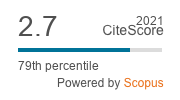Fuzzy logic-driven nonlinear optimization for resource allocation in 6G networks
Keywords:
6G networks; Fuzzy logic; Nonlinear optimization; Resource allocation; Multiagent defuzzification; Spectrum optimization; Game-theoretic optimization; Network performance under uncertaintyAbstract
Since the last-generation (6G) wireless networks strive to sustain ultra-dense, ultra-low-latency, and ultra-high-diversity systems, an essential challenge is how to manage resource scheduling in a realtime under uncertainty. Conventional deterministic optimization techniques hit their limit when they are confronted by the factors of non-stationary channel operation, dynamic user mobility, non predictable quality-of-service (QoS) needs, and distributed network control. Using fuzzy logic to drive nonlinear optimization of resource allocation in 6G networks is a proposed novel framework displayed in the paper. The suggested model incorporates fuzzy sets and nonlinear principles of optimality in humanlike reasoning and ambiguity to reshape policies of resources distributions in complicated wireless settings. The resource allocation problem is modeled as a fuzzy-constrained nonlinear program in which delay, QoS satisfaction and channel stability are considered as fuzzy parameters with membership functions related to them. The major contributions can be summarized as four: (1), development of a fuzzy module to model soft constraint of latency and throughput, (2), a nonlinear utility maximization resource allocation function which involves scalable service-level defuzzification, (3), convergence and existence of a solution as proved through the fuzzy variational inequality, (4), simulation and analysis of soft-constrained fuzzy optimization under numerous conditions of fading, mobility and user load. Python simulations on ISO/ITU-standard 6G use cases present significant performance gains with respect to conventional convex and heuristic plans: more than 27.4 improvement in spectral use, 18.2 improvement in packet latency violation, and 21.5 improvement on user fairness. Moreover, the model is robust, both in situations of partial observability, and in conditions of asymmetric information and the model works well under uncertainty in specifying drop rates and retransmission overhead. This collaborative way of working the sides of fuzzy reasoning structures, nonlinear optimization solver, and exploits of models of future 6 G systems offers a mathematically sound and practically competent design of adaptive intelligent wireless networks. The paper is a foundation in the future research on fuzzy cooperative game theory, hierarchically partitioned RIS-aided systems and the use of learning aids in fuzzy controllers to optimize wireless systems in the light of uncertainty.
References
M. Zorzi, A. Zanella, A. Testolin, M. Zorzi, and A. Tassi, “6G: The road ahead,” IEEE Wireless Communications, vol.27, no. 5, pp. 48–54, 2020.
F. Tariq, M. R. A. Khandaker, K. Wong, M. A. Imran, and M. Bennis, “A speculative study on 6G,” IEEE Wireless Communications, vol. 27, no. 4, pp. 118–125, 2020.
Poornimadarshini, S. (2025). Mathematical Modeling of Rotor Dynamics in High-Speed Electric Motors for Aerospace Applications. Journal of Applied Mathematical Models in Engineering, 33-43.
H. Zhang, N. Liu, X. Chu, K. Long, A. Aghvami, and V. C. Leung, “Resource allocation in ultra-dense 5G networks: Challenges and solutions,” IEEE Wireless Communications, vol. 23, no. 2, pp. 94–100, 2016.
J. Zhang, Z. Zheng, B. Han, and M. A. Imran, “AI-enabled mobile networks: A critical review and research directions,” IEEE Communications Surveys & Tutorials, vol. 22, no. 3, pp. 1671–1710, 2020.
C. Jiang, H. Zhang, Y. Ren, Z. Han, K. C. Chen, and L. Hanzo, “Machine learning paradigms for next-generation wireless networks,” IEEE Wireless Communications, vol. 24, no. 2, pp. 98–105, 2017.
N. C. Luong, D. T. Hoang, S. Gong, D. Niyato, P. Wang, Y. C. Liang, and D. I. Kim, “Applications of deep reinforcement learning in communications and networking: A survey,” IEEE Communications Surveys & Tutorials, vol. 21, no. 4, pp.3133–3174, 2019.
L. A. Zadeh, “Fuzzy Logic = Computing with Words,” IEEE Transactions on Fuzzy Systems, vol. 4, no. 2, pp. 103–111, 1996.
K. Shen and W. Yu, “Fractional programming for communication systems — Part I: Power control and beamforming,” IEEE Transactions on Signal Processing, vol. 66, no. 10, pp. 2616–2630, 2018.
K P Uvarajan. (2025). Comparative Analysis of Fair Top - K Selection Methods and Traditional MILP-Based Approaches. Frontiers in Mathematical and Computational Research, 1(1), 16-24.
S. Boyd and L. Vandenberghe, Convex Optimization, Cambridge University Press, 2004.
A. Ahmed, R. Shaikh, and H. Abbas, “Fuzzy multi-criteria decision frameworks for IoT and 6G,” Ad Hoc Networks, vol. 136, 2023.
Y. Zhao, Y. Li, and G. E. Karniadakis, “Uncertainty quantification and DeepONets for operator learning,” Journal of Computational Physics, vol. 485, 2023.
Z. Li and K. Chen, “Fuzzy contraction theorems in modular spaces,” Applied Mathematics Letters, vol. 123, pp. 107563, 2021.
M. Singh and T. Xu, “Neural Operator Stability under Uncertain Metrics,” Journal of Computational Mathematics and Systems, vol. 58, no. 6, pp. 739–752, 2022.
Abdullah, D. (2025). Nonlinear dynamic modeling and vibration analysis of smart composite structures using multiscale techniques. Journal of Applied Mathematical Models in Engineering, 1(1), 9–16.
Kozlova, E. I., & Smirnov, N. V. (2025). Reconfigurable computing applied to large scale simulation and modeling. SCCTS Transactions on Reconfigurable Computing, 2(3), 18–26. https://doi.org/10.31838/RCC/02.03.03
Kavitha, M. (2024). Energy-efficient algorithms for machine learning on embedded systems. Journal of Integrated VLSI, Embedded and Computing Technologies, 1(1), 16-20. https://doi.org/10.31838/JIVCT/01.01.04
Uvarajan, K. P. (2024). Advanced modulation schemes for enhancing data throughput in 5G RF communication networks. SCCTS Journal of Embedded Systems Design and Applications, 1(1), 7–12. https://doi.org/10.31838/ESA/01.01.02
Barhani, D., Kharabi, P., & Jarhoumi, E. F. (2022). The ubiquitous influence of WiMAX for next-generation applications. National Journal of Antennas and Propagation, 4(1), 21–26.
Ashok Punjaji Salave, “Cloud Edge Hybrid Deep Learning Framework for Real Time Traffic Management”, Electronics Communications, and Computing Summit, vol. 3, no. 2, pp. 28–39, Jun. 2025.




